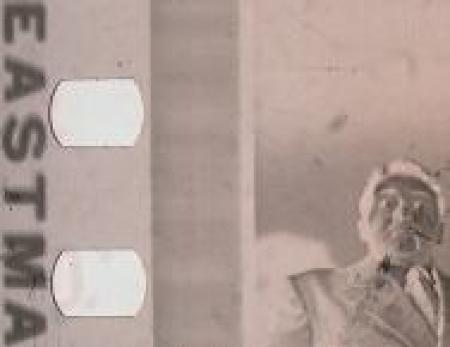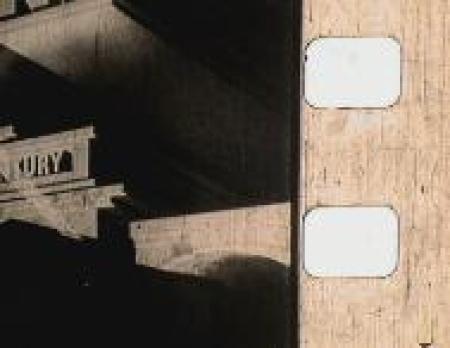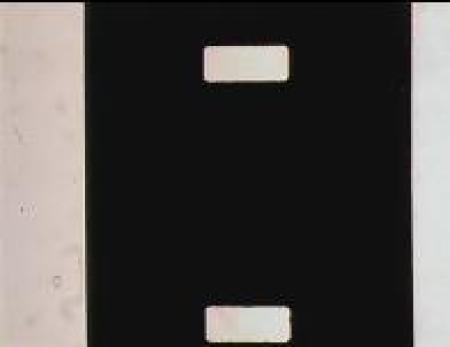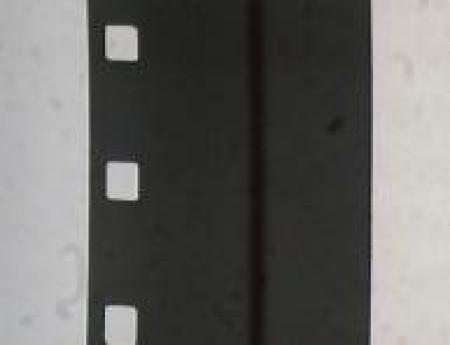
Perforations
Precisely punched hole at the edge of film used for film transport and location for exposure.
History
In the beginning there were various shapes of perforations, and the perforations on 35mm film were noticeably smaller than the present standard perforations. These ‘small gauge’ perforations were customary until about 1905.
The first standard size perforation that came to be established was the ‘negative’ perforation which was used for both negative and positive film stocks.
Then in 1924 Kodak introduced for projection prints their rectangular perforation which is now commonly called the “positive” perforation. This is rectangular with radiused (curved) corners.
The radiused corners tend to distribute the load which is placed on the edge of the perforation when being pulled through the gate of a projector by a sprocket. The negative perforation, on the other hand, has fairly sharp corners, from which tears start more easily, producing the effect sometimes called ‘crowsfoot’. Further, the positive perforation is a little larger in height, which permits a slightly more shrunken film to be accommodated on a given sprocket.
During the period 1910-1930, Pathe used a perforation of a different shape. This had round ends like a negative perforation, but the corners were also curved. The height of these was the same as the positive perforations. these were in use by Pathe until the Pathe film stock factory was taken over by Kodak in 1927.
It should be noted that the positive perforation was not suitable for film to be exposed in cameras. Good cameras used a pin which fitted accurately into a perforation as the means of holding the film stationary in the correct position in the camera gate during exposure of each frame. The larger positive perforation would not fit closely on this ‘register’ pin which would result in unsteady pictures. So although it appeared desirable to establish a single “universal” perforation, this did not prove practicable.
In about 1930, the film stock manufacturers produced special film stocks for duplicating purposes, which they perforated these, (both duplicating negative and duplicating positive) with negative perforations. This was because these would behave better in association with the perforations of the original camera negatives.
During the 1930s an attempt was made to achieve a universal perforation which would fit closely onto the camera register pins, and also behave as well as the positive perforation on prints in projectors. This was the “Dubray-Howell” perforation which was a rectangular perforation with radiused corners, but the same height as the negative perforation. It did not achieve general acceptance when Kodak brought out their colour print stock in the early 1950s they, at first, perforated this with the Dubray-Howell perforation, but later reverted to the positive perforation.
Another form of perforation came with the introduction of ‘CinemaScope’ which had four magnetic sound tracks. In order to make space for these four tracks across the width of the film, the perforations were made narrower. These were rectangular, with radiused corners and of the same height as negative and Dubray-Howell perforations, but with a width of only 0.078 inches instead of the 0.110 inches of all the other perforations on 35mm film. The provision of new sprockets to suit these was just one of the modifications which was required to the cinema apparatus in cinemas which were to show the 4-track CinemaScope.
These perforations were commonly called ‘Foxholes’ after 20th Century Fox who introduced CinemaScope.
A further point which should be stated is that the film stocks for photographic (optical) sound recording are provided with positive perforations. So, sound track negatives almost universally now have positive perforations. In the early years of the sound era most sound negatives had negative perforations.
The situation with perforations in the East European countries is, in some respects, different from elsewhere. These countries have achieved standardization on the positive perforation for all purposes, except for CinemaScope. In these countries the CinemaScope 4-track films had perforations the same height as positive perforations (0.078 inches) and also 0.078 inches wide, (i.e. a square perforation with radiused corners).

| Perforation Type | Tolerances +/- | |||||||
|---|---|---|---|---|---|---|---|---|
| Bell&Howell | Kodak Standard | 16 Millimeter | ||||||
| Dimension | Inches | mm | Inches | mm | Inches | mm | Inches | mm |
| C | 0.110 | 2.794 | 0.110 | 2.794 | 0.072 | 1.828 | 0.0004 | 0.010 |
| D | 0.073 | 1.854 | 0.078 | 1.981 | 0.050 | 1.270 | 0.0004 | 0.010 |
| H | 0.082 | 2.08 | ||||||
| R | 0.020 | 0.51 | 0.010 | 0.25 | 0.001 | 0.03 | ||






16mm
In 16mm there has always been only one shape and size of perforation for all purposes. This is of rectangular shape with radiused corners.
The National Film and Sound Archive of Australia acknowledges Australia’s Aboriginal and Torres Strait Islander peoples as the Traditional Custodians of the land on which we work and live and gives respect to their Elders both past and present.


